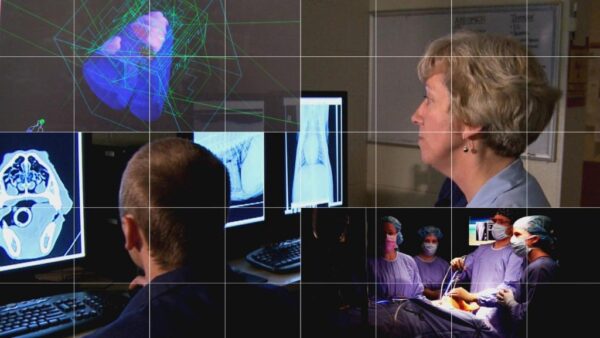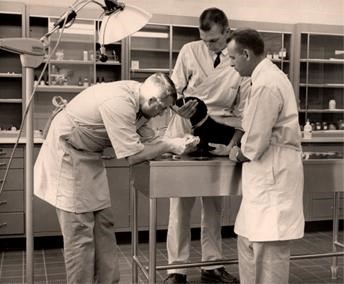Our History
Prior to the creation of the AAVMC, the deans of the colleges worked closely with the AVMA on academic matters and met informally as the Association of Deans of American Colleges of Veterinary Medicine during the AVMA’s annual convention.
AAVMC was chartered as an independent nonprofit corporation in Illinois in 1966. That was the same year the federal government passed the transformational Veterinary Medical Education Act. Founding members included all of the 18 U.S. colleges and three Canadian colleges then in existence. The deans of the colleges were designated as the member representatives. That same year, by-laws were drafted to extend membership to departments of veterinary science. The origins of AAVMC’s Comparative Data Report trace back to these earliest days of the organization’s founding.
The deans quickly recognized that the association needed a voice in Washington to build support from Congress and executive agencies like the National Institutes of Health (NIH), and former NIH staffer and AVMA employee W. Max Decker was contracted to address that work. Decker would become the first formal AAVMC employee when he signed on as part- time director and treasurer in 1977.
In 1972, the AAVMC Assembly was created and the organization was reorganized into a tri-cameral structure. It consisted of three Councils: the Council of Deans, the Council of Chairs (department chairs), and the Council of Educators (individual faculty). That year was also the first year of the Iverson Bell Symposium, which was designed to enhance diversity in veterinary medicine.
The first major corporate support for AAVMC occurred in 1975, when Merck Chemical Division provided $10,000 to support its initiatives.
In 1984, AAVMC was reorganized again. The tri-cameral structure was eliminated, new by-laws were drafted, and a board of directors with an executive committee was established. The need for a formal presence in Washington remained paramount.
In 1986, a permanent Washington office was established and Billy Hooper, former associate dean for academic affairs at the Purdue University School of Veterinary Medicine, was named the first full-time executive director. It was a giant step forward that raised AAVMC’s national visibility and increased program development
That move positioned academic veterinary medicine to effectively engage with the Pew National Veterinary Education Program, a transformational strategic planning and diversity program operated by the charitable trust for academic veterinary medicine from 1987–1989.

Since then, AAVMC has partnered with allied organizations on several major national initiatives established to foster progress in veterinary medicine, including the National Commission on Veterinary Economic Issues, the North American Veterinary Medical Education Consortium, and others.
The national common application service, known today as VMCAS, was launched in 1995. On April 25, 1997, AAVMC was re-incorporated in Washington, D.C. Since then, the organization has grown rapidly in scope and impact.
Key Federal Studies and Legislation
Over the past 50 years, the course of academic veterinary medicine has been heavily influenced by studies like the U.S. Senate’s 1961 “Veterinary Medical Science and Human Health” study and the National Academy of Sciences’ “New Horizons for Veterinary Medicine in 1972” study.
Those studies highlighted the growing importance of veterinary medicine to the nation’s well-being and led to federal government investments that expanded and enhanced academic veterinary medicine.
The Veterinary Medical Education Act of 1966 extended the provisions of the Health Professions Educational Assistance Act of 1963 to veterinary medicine. The Comprehensive Health Manpower Training Act of 1971 provided resources for bricks and mortar, loans, and scholarships.
Seeking federal support and shaping legislation to advance the interests of academic veterinary medicine remains a core priority of AAVMC.
Upon the Shoulders of Giants
Visionary, dedicated leaders have shaped AAVMC's future. Among many champions, these stand out:
W.W. Armistead, former dean of colleges at Texas A&M University, Michigan State, and the University of Tennessee, helped found AAVMC, served two terms as president, was founding editor of the Journal of Veterinary Medical Education, and led the creation of the Federation of Associations of Schools of the Health Professions in Washington, D.C.
Lester Crawford, former commissioner of the Food and Drug Administration and associate dean for research at the University of Georgia, provided key leadership for AAVMC on two occasions and served as JVME editor.
Billy Hooper, former associate dean of academic affairs at the Purdue University School of Veterinary Medicine, was a defining leader for AAVMC throughout the 1970s and 1980s and served as the first executive director.
William R. Pritchard, former dean of the University of California – Davis School of Veterinary Medicine, provided international perspectives and leadership for academic veterinary medicine and co-chaired the Pew National Veterinary Education Program.
Jack Stockton, former dean of the Purdue University College of Veterinary Medicine, served as AAVMC president and is credited with leading the organization through the formative years of the 1970s.
Richard B. Talbot, former dean of colleges at the University of Georgia and Virginia-Maryland, edited the JVME from 1980-1994 and was a powerful voice for progress and innovation in the profession.
John R. Welser, former dean of the Michigan State University College of Veterinary Medicine and Vice President of the Upjohn Company, provided early leadership to develop corporate support and led the drive to establish a Washington, D.C. office.
